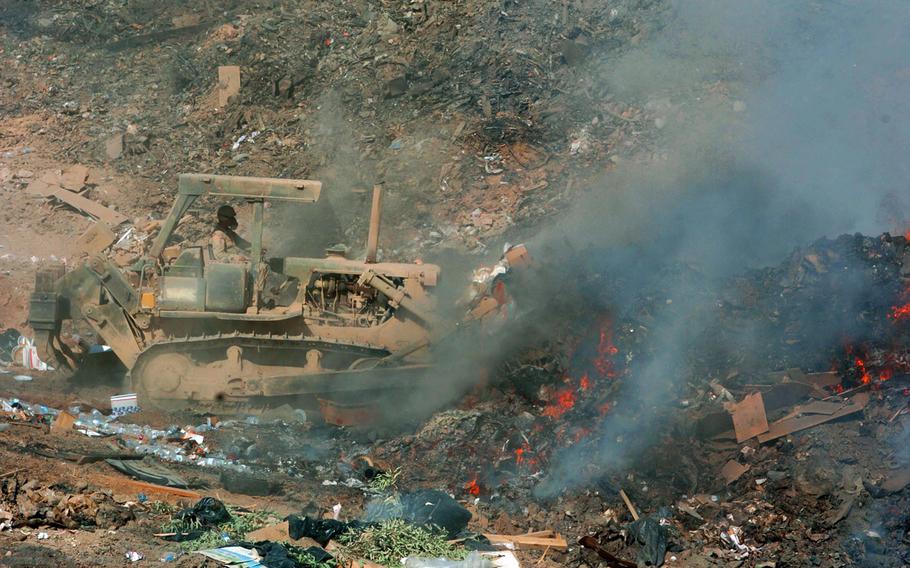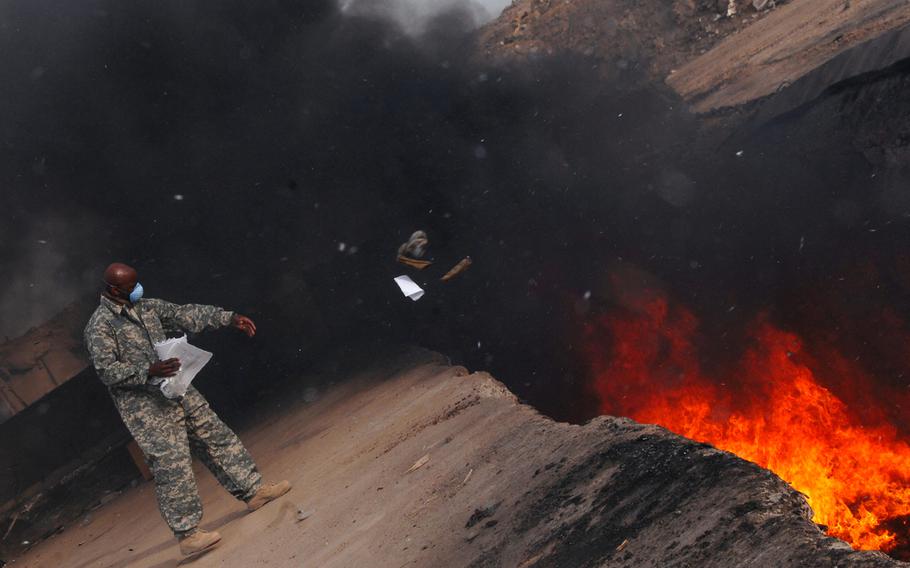
Sgt. Richard Ganske, a soldier with the 84th Combat Engineer Battalion, uses a bulldozer to push refuse into a burn pit in Balad, Iraq, on Sept. 24, 2004. Inclusion on the Department of Veterans Affairs burn pit registry is now automatic for certain deployment locations, including Iraq. (Abel Trevino/U.S. Army)
The registry of people exposed to toxic fumes while serving in the U.S. military is now automatically including those who deployed to Iraq, Afghanistan or any of the Middle Eastern, African and Asian nations on a newly expanded list.
The revamped Airborne Hazards and Open Burn Pit Registry contains the names of approximately 4.7 million current and former service members from campaigns as far back as 1990, the Defense Department said in a statement Thursday.
Legislation requiring the Department of Veterans Affairs to create the registry stemmed from the raft of medical issues reported by veterans of the wars in Iraq and Afghanistan, where burn pits were used extensively to dispose of trash.

Master Sgt. Darryl Sterling, an equipment manager with the 332nd Expeditionary Logistics Readiness Squadron, tosses unserviceable uniform items into a burn pit at Balad Air Base, Iraq, on March 10, 2008. Inclusion on the Department of Veterans Affairs burn pit registry is now automatic for certain deployment locations, including Iraq. (Julianne Showalter/U.S. Air Force)
“Being part of the registry is a way for individuals to help and improve our understanding of the challenges faced by service members and veterans affected by these exposures,” Dr. Lester Martinez-Lopez, assistant secretary of defense for health affairs, said in the statement.
The latest version not only makes inclusion automatic and based on deployment location, but also eliminates the need for the questionnaire the VA had been using for registry enrollment.
Applicants found the 140-question document lengthy and difficult to answer, according to an October 2022 study released by the National Academies of Sciences, Engineering and Medicine.
It found that the registry could not support research for the cause or origin of a veteran’s disease or condition or adequately monitor those exposed to airborne hazards.
It’s unclear whether the questionnaire is gone for good. A VA spokesman did not immediately respond to a request for clarification Friday.
As with the old system, no medical information is stored in the registry, the VA website said. The data includes military personnel information and demographics, such as service members’ gender, race and ethnicity, as well as deployment locations.
The data is accessible only to a select group of VA epidemiologists and researchers, it added.
The registry was launched in 2014 at the direction of Congress to spur clinical research and advance treatments for troops who had been exposed to toxic pollutants.
Those enrolled in the previous registry were carried over to the new system, the VA website said. Procedures have also been added so service members and veterans can opt out or re-enter the registry.
Active-duty service members can submit an inquiry to confirm their enrollment status, while veterans can contact their local environmental health coordinator, the VA said.
For anyone who wants to join the registry manually, instructions on the website explain the process. More information is available online or by phone at 1-800-698-2411.
Inclusion is based on Defense Department records and not on any specific exposure, the VA said. Veterans or service members, living or dead, will be enrolled if they served in:
Desert Shield, Desert Storm, Iraqi Freedom, Enduring Freedom or New Dawn
Iraq, Afghanistan, Kuwait, Saudi Arabia, Bahrain, Djibouti, the Gulf of Aden, the Gulf of Oman, Oman, Qatar, the United Arab Emirates, Persian Gulf waters, the Arabian Sea, the Red Sea, Syria or Uzbekistan between Aug. 2, 1990 and Aug. 31, 2021
Somalia, Egypt or the Southeast Asian theater of military operations since Aug. 2, 1990
Afghanistan, Djibouti, Jordan, Lebanon, Syria, Uzbekistan or Yemen anytime after Sept. 11, 2001
Airspaces associated with the aforementioned countries.
Care and benefits are not affected by participation in the burn pit registry, according to the VA website.